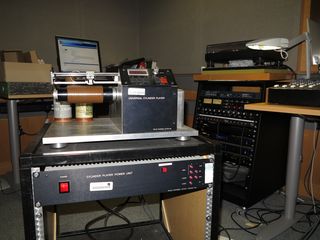In my last post, I offered a selection of three short recordings that form part of the ethnographic wax cylinder collections housed and available for listening at the British Library.
Coming towards the end of processing this 3500 strong collection, this follow-up post offers some further musical highlights that caught my ear whilst listening to thousands of recordings. I think they are of some significance, offering good examples of some of the earliest (and pioneering) music recordings taken from various locations around the world, and are therefore worth sharing.
Collection Samples
1) C37/1590, English Folk Dance and Song Society Collection. The English Folk Dance and Song Society (EFDSS) is one of the leading folk development organisations in the UK with a history dating back to 1898. This recording is one of 106 cylinders (on long-term loan to the British Library from the EFDSS) comprising several smaller British folk music collections (Welsh, Scottish and English) recorded by Cecil Sharp and Vaughan Williams, and others. Recorded in Herefordshire, England, in 1908 by Cecil James Sharp (1859-1924), this recording is in two parts. The first part is a male vocal solo sung by an unknown performer. The performance is entitled ‘there is an ale house (died for love)’. The second part is a solo fiddle performance, possibly by John Locke, of a hornpipe: a music/dance form popular in Britain from the late 17th century.
025A-C0037X1590XX-0001A0
2) C51/2611, Northcott Whitridge Thomas Collection. Thomas (1868–1936) was a British government anthropologist who conducted field research in Nigeria and Sierra Leone between 1909 and 1915, recording songs, music and the spoken word onto hundreds of wax cylinders. This example was recorded in the Kaba, Akoko region of Nigeria by Thomas on the 4 March 1910: a spirited male vocal group performance.
025A-C0051X2611XX-0001A0
3) C51/2853, Northcott Whitridge Thomas Collection. Another sample from the Thomas Collection recorded in the Ugwashi Uku, Ibo region of Nigeria on the 25 November 1912. This is a female vocal group with leader, accompanied by clapping.
025A-C0051X2853XX-0001A0
4) C72/820, Fox Strangways Cylinder Collection. This collection of 101 high quality recordings were made in India between 1910 and 1911 by British ethnomusicologist, Arthur Fox Strangeways. This is a good example of Shahnai (double-reed conical woodwind instrument of North India) music with drum accompaniment that was recorded in India around 1910 by Fox Strangways. It features a performance of Rag Sarang, Rag Adachautal and four thekas (repeated patterns of rhythmic strokes played on the drums).
025A-C0072X0820XX-0001A0
5) C664/641, Berlin Demonstration Cylinder Collection. This collection is an early anthology of traditional music compiled by the Psychological Institute of the University of Berlin. It contains 107 recordings made between 1903 and 1913 in various locations including China, Japan, Java, Borneo, Africa, Russia, the Solomon Islands and Papua New Guinea. This example was recorded in East Africa (date unknown) and is of a 'waNyamwezi drinking song' performed by an unaccompanied male vocalist.
025A-C0664X0641XX-0001A0
Work Completed
The general approach taken to working on each wax cylinder collection was, firstly, to familiarise myself with previous work completed by a number of engineers and curators at the British Library. This involved delving into paper files, correspondences and technical reports that have amassed since work began on the collections in 1994. Secondly, this information was checked against existing catalogue entries and online sources for consistency and accuracy, and where necessary entries were updated. Thirdly, I listened to the majority of the 3500 previously digitised recordings and checked the contents against the catalogue entries and paper files. On occasion, I requested that the original cylinders were re-dubbed by engineers at the British Library as the files were missing, or they had been dubbed at the wrong playing speed. This work was done on a universal cylinder player build at the British Library for dubbing the ethnographic wax cylinder collections:

The British Library's Universal Cylinder Player
Fourthly, technical metadata (e.g. dubbing speeds, dubbing dates, filenames and engineer’s names) was added to catalogue entries. Lastly, after some final consistency and accuracy checks, the cylinder collections were uploaded onto the British Library catalogue where the documentation can be viewed and the recordings are available for listening by the public.
Further sample recordings taken from wax cylinder collections are also for public access at sounds.bl.uk.
We were very saddened to hear of the death of Steve Martland, one of the most innovative British composers of his generation. Born in Liverpool in 1959, he studied composition with Louis Andriessen in The Hague. In many of his works one can hear the influence of American minimalism refracted through Andriessen's lens, but with many new aspects thrown in for good measure: a relentless rhythmic drive, very often amplified wind instruments, elements of jazz and rock, and a disciplined concern for overall form which perhaps owes something to his friend Michael Tippett.